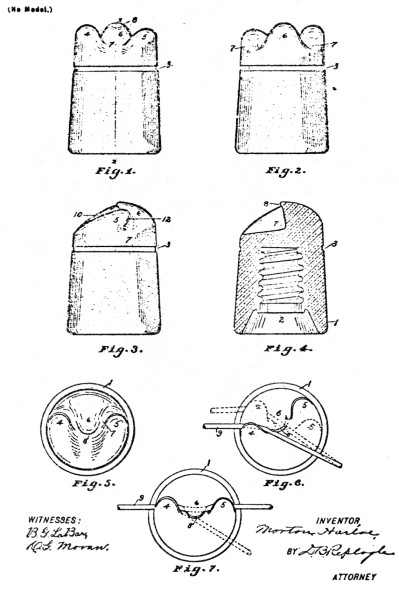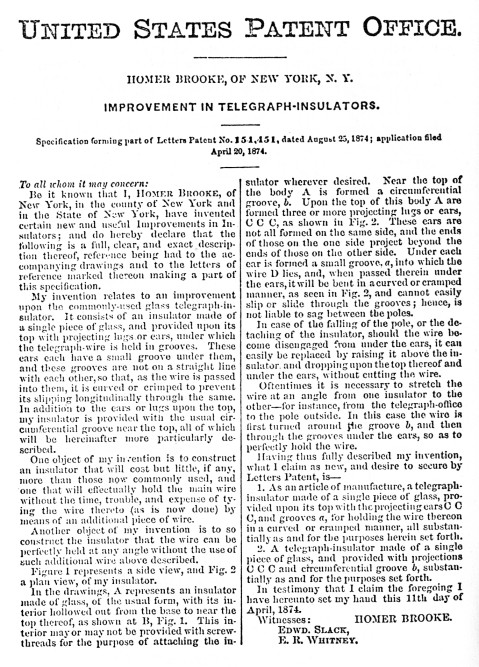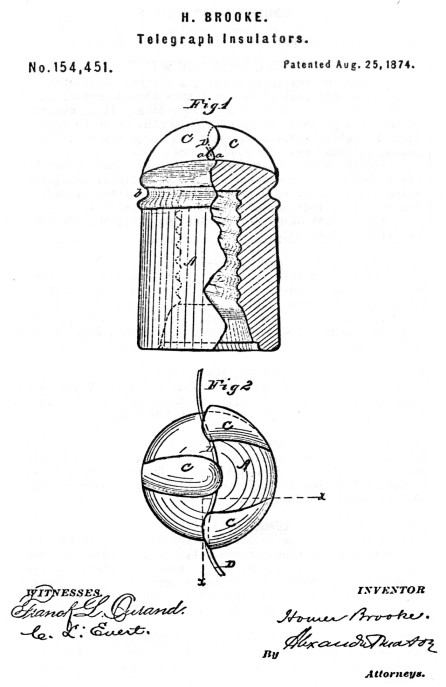Patent Pages
by Ray Klingensmith
Reprinted from "INSULATORS - Crown Jewels of the Wire", May 1978, page 34
This month - a very interesting item - the 1874 Homer Brooke patent. To my
knowledge, none of these have been found to date. I term this item the
"Brooke's Harloe" because of its striking resemblance to the Dec. 9,
1902 patent issued to Morton Harloe. In fact, I wonder if maybe Harloe copied the
Brooke's Insulator for his own manufacture.
As I stated, none of these have been
found; but I'm almost 100% sure they were manufactured, because of Brooke's
involvement in the production of other insulator styles. And he plainly states
in the accompanying patent copy that "...the insulator is made of
glass", and that "...they would cost little if any more than insulators now commonly used". That, along with his other
involvement with
insulators, leads one to believe they were manufactured.
Homer Brooke was
associated with other insulator patents also. I recall reading somewhere that
Brooke was a mold maker in New York. On January 25, 1870 he was granted a patent
for a process of forming threads in insulators and other glass articles. This
date appears on the base embossed CD 127 and is embossed: H. Brooke's Pat. Jan.
25th 1870. This patent may have been leased or sold to Brookfield, as many early
Brookfield items carry that date.
The CD 131 Tillotsons marked "Brooke's
Pat" and the CD 131.4 LGT&CO units were also made under that patent.
Listed in Milholland's Most About Glass Insulators is a CD 731 threadless
Tillotson with "Brooke's Pat." embossed on the skirt. This item was
more than likely made in the same molds which were used to make the CD 131
units. Homer Brooke's name also appears on the CD 120 and CD 133.3 with the Aug.
14, 1883 patent date. This is actually a patent issued to Mathew Johnson of
Ellenville, New York. Brooke must have purchased the Johnson patent.
I guess
by now everyone is wondering why I'm going into all the detail on the other
Brooke's and Johnson's patents. The reason is to show Homer Brooke's involvement
with the production of insulators, and therefore indicating the high chance of
the 1874 patent actually having been produced. There seems to be some link
between Homer Brooke, Mathew Johnson, Ellenville Glassworks, and even the CD 135
"Chicago diamond groove". I hope to do a little more research on
this "link" and print it in an upcoming article.
Now, back to the 1874
patent. As I said, this item very much resembles the 1902 Harloe patent. There
are a couple explanations. The patent (Brooke's) having run out, Harloe could
legally produce insulators of the same design. Or Harloe, by changing the design
a little, could have his own "improvement" patented. Although the two
designs appear identical, a minor difference, such as the process of securing
the line wire, etc., could explain the granting of the Harloe patent as being
different. In fact, Harloe, in his application for a patent, stated that his new
design was different than others previously made, possibly referring to the
Brooke's item.
Should this nice early telegraph unit finally appear on the
collecting scene, I'm sure it would create quite a stir. My prediction is that
this item will be found and will definitely have one of two characteristics: it
will be a beautiful "Chicago blue", or will be base embossed. (Now
I'll be known as the fortune teller.)
Below are some drawings from the Harloe patent application; and the following
two pages show the complete 1874 Brooke's patent. Notice the similarity
between the two items.
A real big THANKS must go out to the Branhams of New
Jersey for all their hard work and efforts in copying the patents from
1851-1885, and putting them in book form. It was their efforts which will make
this column so much easier to compile each month.
In the June issue: another
super unusual and rare item, the Combination Safety / Safty. (A Safty? What's a
Safty? Wait and see! Surprise!)

Large Image (150 Kb)

Large Image (435 Kb)

Large Image (160 Kb)
| 